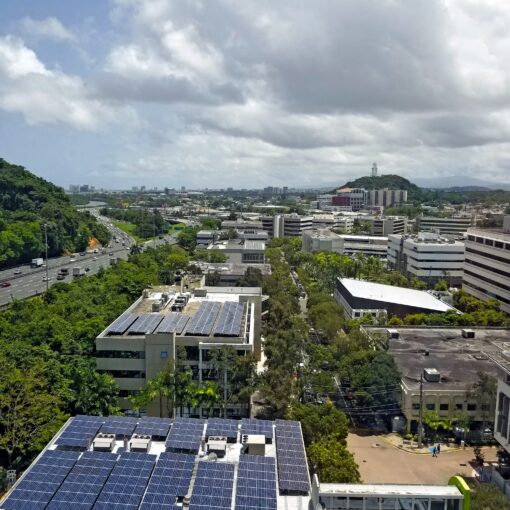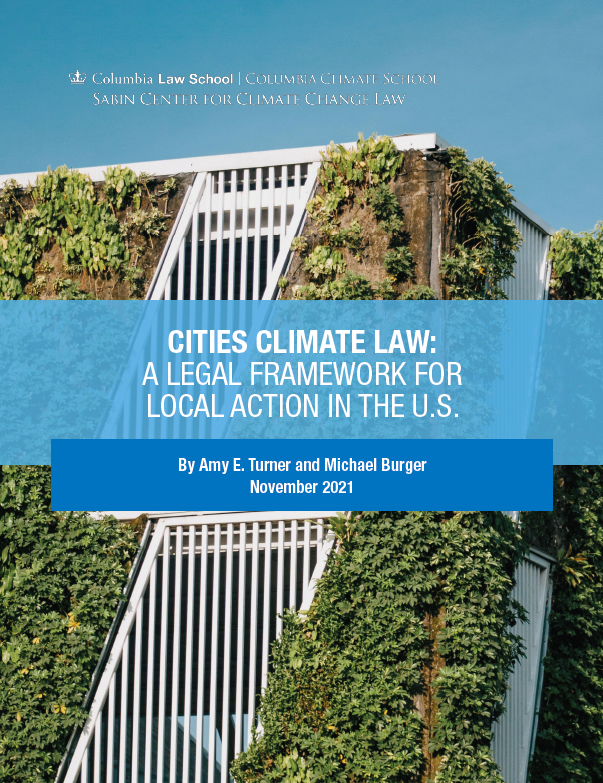 On June 14, 2023, the U.S. Treasury Department and the Internal Revenue Service (IRS) issued temporary and proposed rules for the “direct pay” mechanism enabled by the 2022 Inflation Reduction Act (IRA) and codified under Section 6417 of the Internal Revenue Code. Direct pay – which is already in effect as of January 1, 2023 – allows tax-exempt entities, including local governments, to claim the value of certain clean energy and other tax credits as a cash payment, rather than as an offset to tax liability that they do not have. (Direct pay is formally referred to as “elective pay” or an “elective payment” by the IRS; this post uses the informal term “direct pay.”)
On June 14, 2023, the U.S. Treasury Department and the Internal Revenue Service (IRS) issued temporary and proposed rules for the “direct pay” mechanism enabled by the 2022 Inflation Reduction Act (IRA) and codified under Section 6417 of the Internal Revenue Code. Direct pay – which is already in effect as of January 1, 2023 – allows tax-exempt entities, including local governments, to claim the value of certain clean energy and other tax credits as a cash payment, rather than as an offset to tax liability that they do not have. (Direct pay is formally referred to as “elective pay” or an “elective payment” by the IRS; this post uses the informal term “direct pay.”)
Local governments stand to gain considerably from the advent of direct pay, as the mechanism allows them to benefit directly from clean energy tax incentives for the first time. In addition to local governments themselves, “agencies and instrumentalities” of a local government are eligible to claim direct payment: school districts, water districts, economic development agencies, and some public universities and hospitals. Nonprofits within a city may also participate, further increasing the uptake of tax credit-enabled investments like community solar. Direct pay is noncompetitive, meaning that cities and others need not win a grant to participate. Furthermore, the IRA’s tax credits – and direct pay – are in the aggregate uncapped, so the dollars opened up by the IRA are limited only by the ambition of renewable energy developers and investors, including cities.
Direct pay represents a sprawling new program covering many entities and a dozen tax credits (the proposed regulations are more than 100 pages). This blog post reviews details of particular use to cities and other units of local government. Because the Treasury release contains both temporary and proposed rules, this post provides guidance cities can use for investments and purchases in development now, and may also spur thinking on potential comments cities or others might submit on the rulemaking. Written comments are due on August 14, 2023.
Eligible Tax Credits: The tax credits for which a local government may elect to receive direct payment are as follows (numbers are references to the applicable Internal Revenue Code provisions):
- 30C (alternative fuel refueling property): up to a 30% tax credit for cost of natural gas, propane, hydrogen, electricity, E85, or diesel fuel blend vehicle fueling equipment
- 45 (renewable electricity production credit): a per-kW tax credit based on production of renewable energy
- 45Y (clean electricity production credit): a technology-neutral version of the Section 45 credit that phases in in 2025
- 48 (energy investment tax credit): a 6% to 30% credit for the cost of a renewable energy facility
- 48E (clean electricity investment credit): a technology-neutral version of the Section 48 credit that phases in in 2025
- 45Q (carbon oxide sequestration credit): acredit of between $12 and $180 per ton of carbon oxide captured and sequestered, injected or used
- 45U (zero-emission nuclear power production credit): a per-kW tax credit based on the production of nuclear energy
- 45V (clean hydrogen production credit): a per-kg credit for producing clean hydrogen at a qualified, U.S. facility
- 45Z (clean fuel production credit): a per-gallon credit for domestic production of clean transportation fuels, including sustainable aviation fuel
- 45X (advanced manufacturing production credit): a production tax credit for domestic manufacturing of components of clean energy projects
- 48C (qualifying advanced energy project credit): a 6% to 30% tax credit for investment in advanced energy projects
- 45W (clean commercial vehicles): up to a 30% tax credit ($40,000 maximum) for purchase of a qualified clean commercial vehicle
Of these, local governments are most likely to use the Sections 45 and 45Y energy production tax credits (PTC), the Sections 48 and 48E clean energy investment tax credits (ITC), the 30C alternative refueling property credit, and the 45W qualified commercial vehicle credit. In general, the direct pay claimant, including a unit of local government, must own the project (not necessarily in full, though partnership rules can complicate direct pay eligibility) in order to qualify for direct pay.
Tax Credit Adders: Some tax credits introduced or expanded by the IRA allow for a higher tax credit if certain criteria are met. For example, the amount of the ITC (Sections 48 and 48E) and the PTC (Sections 45 and 45Y) is increased for certain projects that meet applicable wage and apprenticeship requirements, that meet applicable domestic content minimums, and/or are sited in “energy communities .” The ITC also offers bonus credit for projects that are sited in low-income communities, or on Indian Land, or that are qualified low-income residential building projects or economic benefit projects. Some of these bonus credits require a separate application and approval process. Under the proposed rules, these bonus and extra credit amounts are all eligible for direct pay.
Interaction with Grants, Loans & Tax-Exempt Bonds: Parties electing direct pay with respect to a project, investment, or expense may combine the direct pay with grants, forgivable loans, or tax-exempt bonds; however, they may not do so in excess of the total cost (or basis) of the project. In other words, no one should expect to make money from direct pay. Combining sources of funding is also subject to any additional rules, which may vary between programs.
The IRS provides the following examples (heavily paraphrased here):
- Example 1: School District uses a $400,000 tax-exempt grant to purchase a $400,000 school bus. Separately, School District is eligible for up to $40,000 in direct pay under the Section 45W clean vehicles credit. However, as School District’s total cost (also referred to as its “basis”) for the school bus is fully covered by the $400,000 grant, it is able to collect $0 from direct pay.
- Example 2: School District combines a $300,000 tax-exempt grant and the $40,000 it is eligible for though the 45W credit to purchase the bus. School District’s basis is $400,000, which exceeds the sum of the grant and the tax credit amounts. Therefore, School District may claim the full $40,000 tax credit through direct pay.
- Example 3 (my example): School District combines a $380,000 tax-exempt grant and the $40,000 it is eligible for though the 45W credit to purchase the bus. School District’s basis is $400,000, but the grant plus the $40,000 would exceed the basis by $20,000. Therefore, the 45W amount receivable through direct pay would be reduced by $20,000.
In addition, using loans to finance a project would generally not disqualify a local government from receiving direct pay with respect to a project, but the rules for each individual credit should be reviewed.
Process for Electing Direct Pay: Local governments and others planning to make a claim for direct pay must first register their projects on an IRS online portal, which will give the projects a registration number for use in later filing(s). The IRS states that the portal will come online later in 2023. After registration, the local government has until the date that its tax filing would be due if it were required to file taxes, plus an automatic six month extension. Late requests to elect direct pay are not permitted, nor are changes to the direct pay election after the initial filing. Thus, while cities will have between several months to well over a year to make a direct pay election with respect to a particular project, they should ensure they are registered and have the information they need to accurately file for direct payment without delay.
At the time the tax filing is (or would be) due, the local government files a Form 990-T, along with IRS Form 3800 (the “general business credit” form), other supporting documentation, including credit calculations, and the registration number it receives from its earlier registration on the online portal. It should be noted that taxable year in which a credit is earned (and therefore becomes eligible for direct pay) varies depending on the credit. Investment tax credits are generally earned during the tax year in which the property is placed in service, while production tax credits are earned over time.
Timing for Payout: Left somewhat unclear is when a city or other eligible entity can expect to receive direct payment funds to which it is entitled. The proposed regulations only suggest that funds will be disbursed after the IRS reviews the claimant’s direct pay filing. Local governments may wish to submit comments requesting further clarity, noting that a better sense of timing would help them structure investments and make better use of direct pay. (Separately, local governments and others may want to consider how the green banks funded by the IRA’s Greenhouse Gas Reduction Fund could address the time period in which a local government has expended funds but not yet received the direct pay reimbursement.)
Excessive Payments: An excessive payment occurs when the taxpayer or direct pay claimant treats a larger than eligible amount as eligible for a tax credit and receives that extra amount as an offset to tax liability or as a direct payment amount. If the IRS determines that a local government has received an excessive payment, the proposed regulations would impose a penalty of the amount of the excessive payment plus 20 percent, with some leeway for the IRS to waive the 20 percent fine if there is a “reasonable cause” for the excessive payment. Reasonable cause is a case-by-case determination for which the IRS may consider “efforts [] made to report the correct tax; the complexity of the tax issue; education, experience, or knowledge of tax law; and steps [taken] to understand [the] tax obligation or seek help from a tax advisor.”
Transferability of Tax Credits: A companion provision to direct pay – Section 6418 of the Internal Revenue Code – allows for the transferability between tax-paying entities of many of the same credits to which direct pay applies (formally termed “credit transfer”). For the most part, these two mechanisms are entirely separate: an entity that receives a credit pursuant to Section 6418 cannot then claim it as a direct payment. Local governments and other nontaxpayers are not permitted under the proposed rules to use transferability. (Treasury is seeking input on very limited circumstances in which commenters suggest it should allow exceptions to its total separation of the direct pay and transferability mechanisms.)
Project Complexity: Renewable energy project structures vary in their complexity. Some of the tax credits for which direct pay is available are very straightforward, especially the 45W clean commercial vehicles credit, which offers up to $40,000 or 30% (whichever is less) of the cost of a commercial EV and therefore involves little transaction complexity. Slightly more complex are the ITC and PTC, for which a project developer (local governments included) have to choose only one. For a small-scale renewable energy project, a municipality may be able to rely on minimal legal assistance. Many of the renewable energy deals traditionally financed with the help of tax credits have traditionally been very complex, requiring attorneys, financial advisors, and equity investors. Both direct pay and section 6418 transferability are meant to streamline the convoluted nature of some tax-financed renewable energy projects; however, local governments will need to consult with qualified tax counsel for more complex renewable energy investments.
All in all, the proposed and temporary rules contain few surprises for local governments that have relatively simple plans for their use of available tax credits. Key to accessing direct pay will be careful documentation of the credits earned, pre-registration on the IRS web portal, and a timely filing of an annual tax returns (in addition to any extensions). Local governments will separately need to apply for some of the bonus credits, like the Low Income Communities Bonus Credit, and direct pay credits may be combined with grants, including IRA grants. Local governments will not be able to use or combine direct pay with the transferability of credits, and they must actually own the project or property that is the subject of any claimed credits (though legal counsel may be able to advise on permissible “tenancy in common” or other appropriate arraignments). Of particular interest to local governments may the timing of payment for direct pay, which the IRS only notes is to happen after review of a tax return, meaning that there will be a period of months to more than a year (or longer for production tax credits) where cash or alternative financing will need to be arranged. Local governments may submit written comments on any of this.
While direct pay’s full potential has yet to be demonstrated, it represents a promising new tool for local governments. With a relatively small amount of care and work, a significant new source of funding is opened up for local renewable energy projects and commercial EV investments.
Amy Turner is the Director of the Cities Climate Law Initiative at the Sabin Center for Climate Change Law at Columbia Law School.






